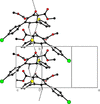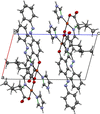issue contents
May 2024 issue
Early view articles

research communications
Download citation


Download citation


In the structure of the title co-crystal, C3H3N3O2·C5H8N2, the components are linked by a set of directional O—H⋯N, N—H⋯O, N—H⋯N and C—H⋯O hydrogen bonds to yield a two-dimensional mono-periodic arrangement. The structure propagates in the third dimension by extensive π–π stacking interactions of nearly parallel molecules of the two components, following an alternating sequence. The primary structure-defining interaction is very strong oxime-OH donor to pyrazole-N acceptor hydrogen bond [O⋯N = 2.587 (2) Å], while the significance of weaker hydrogen bonds and π–π stacking interactions is comparable.
CCDC reference: 2343837
Download citation


Download citation


In the title compound, molecules are connected by intermolecular C—H⋯S hydrogen bonds with ![[R_{2}^{2}]](/e/issues/2024/05/00/nx2007/teximages/nx2007fi1.svg) (10) ring motifs, forming ribbons along the b-axis direction. C—H⋯π interactions consolidate the ribbon structure while van der Waals forces between the ribbons ensure the cohesion of the crystal structure.
(10) ring motifs, forming ribbons along the b-axis direction. C—H⋯π interactions consolidate the ribbon structure while van der Waals forces between the ribbons ensure the cohesion of the crystal structure.
CCDC reference: 2344995
Download citation


Download citation


The synthesis, crystal structure and Hirshfeld analysis of cis-jasmone 4-ethylthiosemicarbazone are reported. The crystallographically independent molecule shows disorder over the jasmone carbon chain and, in the crystal, the molecules are linked by H⋯S and H⋯N interactions into mono-periodic hydrogen-bonded ribbons parallel to the b-axis.
CCDC reference: 2304271
Download citation


Download citation


δ-Valerolactone was reacted with hydrazine hydrate in methanol affording crystals of 5-hydroxypentanehydrazide, which were characterized via single-crystal X-ray diffraction. The compound crystallizes in the orthorhombic space group Pca21 without any crystallization solvent. The hydrazide functional group shows C—N and C=O bond lengths measuring 1.3376 (17) Å and 1.2375 (16) Å, respectively.
CCDC reference: 2345070
Download citation


Download citation


In the crystal structure of the title compound, discrete complexes with a rare Co coordination are found, in which the CoII cations are fivefold coordinated by two thiocyanate anions and three 4-methylpyridine N-oxide coligands within a slightly distorted trigonal–bipyramidal coordination.
CCDC reference: 2347581
Download citation


Download citation


The crystal structure is reported of the copper(II) complex with an amino acid Schiff base ligand synthesized from azobenzene-salicylaldehyde, L-leucine and copper(II) acetate. The crystal structure features N—H⋯O hydrogen bonds.
CCDC reference: 2347500

 journal menu
journal menu


























